
Ifugao is a landlocked province of the Philippines in the Cordillera Administrative Region in Luzon. Its capital is Lagawe and it borders Benguet to the west, Mountain Province to the north, Isabela to the east, and Nueva Vizcaya to the south.

Mountain Province is a landlocked province of the Philippines in the Cordillera Administrative Region in Luzon. Its capital is Bontoc.

Aguinaldo, officially the Municipality of Aguinaldo, is a 2nd class municipality in the province of Ifugao, Philippines. According to the 2015 census, it has a population of 19,408 people.

Bucloc, officially the Municipality of Bucloc,, is a 6th class municipality in the province of Abra, Philippines. According to the 2015 census, it has a population of 2,501 people.

Langiden, officially the Municipality of Langiden,, is a 5th class municipality in the province of Abra, Philippines. According to the 2015 census, it has a population of 3,198 people.
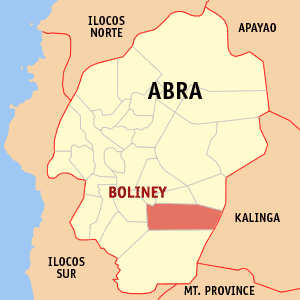
Boliney, officially the Municipality of Boliney,, is a 5th class municipality in the province of Abra, Philippines. According to the 2015 census, it has a population of 3,573 people.

San Quintin, officially the Municipality of San Quintin,, is a 5th class municipality in the province of Abra, Philippines. According to the 2015 census, it has a population of 5,438 people.
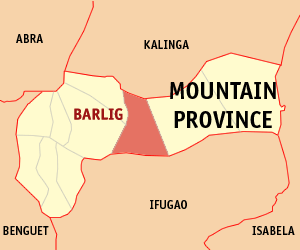
Barlig, officially the Municipality of Barlig is a 5th class municipality in the province of Mountain Province, Philippines. According to the 2015 census, it has a population of 4,819 people.

Natonin, officially the Municipality of Natonin is a 4th class municipality in the province of Mountain Province, Philippines. According to the 2015 census, it has a population of 10,272 people.

Tanudan, officially the Municipality of Tanudan is a 4th class municipality in the province of Kalinga, Philippines. According to the 2015 census, it has a population of 9,534 people.

Kibungan, officially the Municipality of Kibungan,, is a 4th class municipality in the province of Benguet, Philippines. According to the 2015 census, it has a population of 17,292 people.

Alfonso Lista, formerly known as Potia, officially the Municipality of Alfonso Lista is a 3rd class municipality in the province of Ifugao, Philippines. According to the 2015 census, it has a population of 32,119 people.. It was created as the municipal district of Potia in 1955 from the barrios of Potia, Dolowog, San Juan, San Quintin, Cabicalan, Pinto, Busilac, Santa Maria, and Namillangan in the municipal district of Mayaoyao. In 1959 the name was changed to Alfonso Lista to memorialize the first mayor.
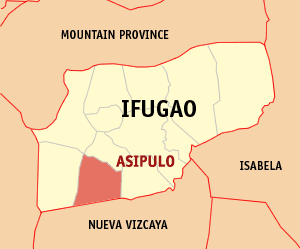
Asipulo, officially the Municipality of Asipulo is a 5th class municipality in the province of Ifugao, Philippines. According to the 2015 census, it has a population of 15,261 people.

Banaue, officially the Municipality of Banaue is a 4th class municipality in the province of Ifugao, Philippines. According to the 2015 census, it has a population of 21,837 people.

Hingyon, officially the Municipality of Hingyon is a 5th class municipality in the province of Ifugao, Philippines. According to the 2015 census, it has a population of 9,227 people.

Hungduan, officially the Municipality of Hungduan is a 4th class municipality in the province of Ifugao, Philippines. According to the 2015 census, it has a population of 9,400 people.
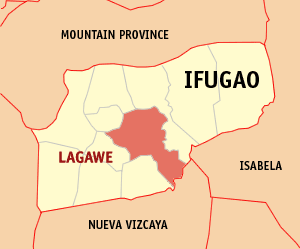
Lagawe, officially the Municipality of Lagawe is a 4th class municipality and capital of the province of Ifugao, Philippines. According to the 2015 census, it has a population of 19,333 people..
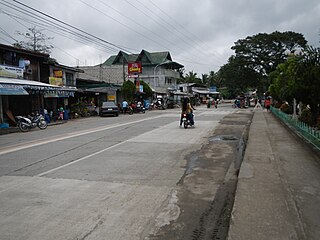
Lamut, officially the Municipality of Lamut is a 4th class municipality in the province of Ifugao, Philippines. According to the 2015 census, it has a population of 25,279 people.
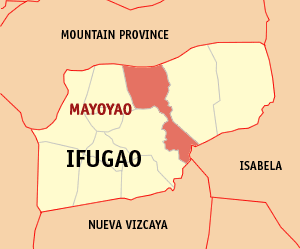
Mayoyao, officially the Municipality of Mayoyao is a 4th class municipality in the province of Ifugao, Philippines. According to the 2015 census, it has a population of 17,331 people.

Tinoc, officially the Municipality of Tinoc is a 4th class municipality in the province of Ifugao, Philippines. According to the 2015 census, it has a population of 16,559 people.


























